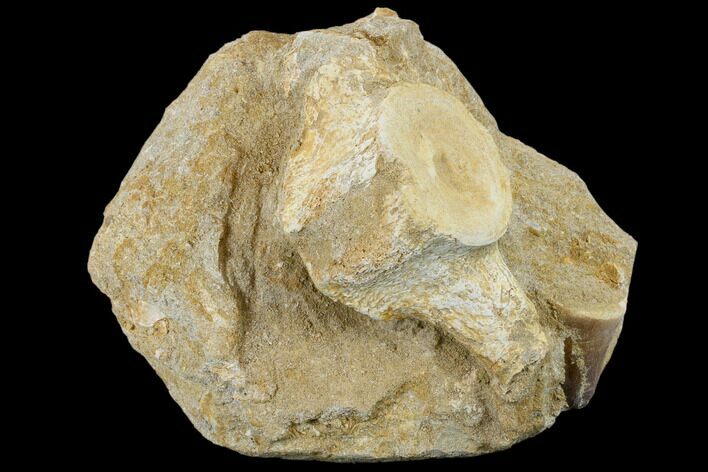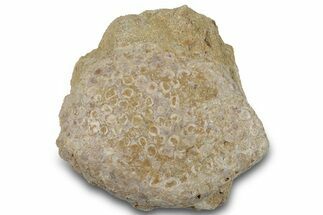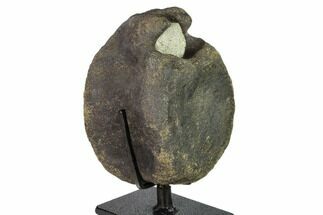This Specimen has been sold.
4.3" Plesiosaur Caudal Vertebra And Mosasaur Tooth - Morocco
This is a 4.3" wide Plesiosaur caudal vertebra from the Upper Cretaceous phosphate deposits in the Oulad Abdoun Basin of Morocco. It is in good condition on the sandstone in which it was found. The left transverse is largely intact with the base of the right transverse process also present. The spinal process is missing. In addition there is a Mosasaur tooth. The rock contains unidentified bone and shell material.
Plesiosaurs were aquatic reptiles. They had small heads, long necks, broad, flattened bodies, short tails and large flippers or paddles. They are one of the best described groups of fossil animals with a total of 110 known species, many from complete or nearly complete fossils. The largest known is Elasmosaurus at 40 feet (12 meters), and the smallest was Thalassiodracon at just under 6 feet (1.5 meters). They first appear in the fossil record near the end of the Triassic Period, starting with Thalassiodracon from about 203 million years ago. They disappear from the fossil record about the time of the Cretaceous-Paleogene Extinction, along with the dinosaurs and most other reptiles.
Plesiosaurs were almost comical in their appearance: small heads full of sharp, cylindrical teeth; wide, comparatively flat bodies; short tails; and four large paddles or flippers. They are so odd-looking that when originally found, the first Plesiosaur fossil was mistaken for a new kid of Pterosaur. Even when the first Plesiosaur went on display, it had its head mounted on the wrong end! Plesiosaur necks could also have large numbers of vertebrae: Albertonectes had 72 in its neck!
Plesiosaurs swam by moving their paddles or flippers in much the same way that modern sea turtles do. This would have made them efficient and maneuverable, but not particularly speedy. Due to their long, thin necks and flippers, it is unlikely that Plesiosaurs left the water. If they did, they would not have been able to travel far. It had long been thought that Plesiosaurs left the water to lay eggs in much the same way as modern sea turtles. Recent evidence seems to prove they bore live young, making theories that they left the water less likely. It is widely held that plesiosaurs were not the fastest swimmers in the sea, cruising to catch their preys of various fish, squid, and other mollusks.
Plesiosaur fossils have been found worldwide. The first described fossil was found in Kansas. Since then, they have been found on every continent. Most commercially available Plesiosaur fossils come from Morocco and Kansas.
Plesiosaurs were almost comical in their appearance: small heads full of sharp, cylindrical teeth; wide, comparatively flat bodies; short tails; and four large paddles or flippers. They are so odd-looking that when originally found, the first Plesiosaur fossil was mistaken for a new kid of Pterosaur. Even when the first Plesiosaur went on display, it had its head mounted on the wrong end! Plesiosaur necks could also have large numbers of vertebrae: Albertonectes had 72 in its neck!
Plesiosaurs swam by moving their paddles or flippers in much the same way that modern sea turtles do. This would have made them efficient and maneuverable, but not particularly speedy. Due to their long, thin necks and flippers, it is unlikely that Plesiosaurs left the water. If they did, they would not have been able to travel far. It had long been thought that Plesiosaurs left the water to lay eggs in much the same way as modern sea turtles. Recent evidence seems to prove they bore live young, making theories that they left the water less likely. It is widely held that plesiosaurs were not the fastest swimmers in the sea, cruising to catch their preys of various fish, squid, and other mollusks.
Plesiosaur fossils have been found worldwide. The first described fossil was found in Kansas. Since then, they have been found on every continent. Most commercially available Plesiosaur fossils come from Morocco and Kansas.
Mosasaurs were a family of enormous marine reptiles that truly dominated the seas 90 million years ago, ruling during the last 20-25 million years of the Cretaceous period. With the extinction of the ichthyosaurs and decline of plesiosaurs, mosasaurs diversified to become prolific apex predators in nearly every habitat of the oceanic world.
Larger mosasaurs were the great leviathans of their time, extending 10–15 meters, or 33–49 feet long. Hainosaurus holds the record for the longest mosasaur at a seemingly impossible 57 feet. The smaller genera were still an impressive 10–20 feet long.
Mosasaurs probably evolved from semi-aquatic scaled reptiles, perhaps more similar in appearance to modern-day monitor lizards. They had double-hinged jaws and flexible skulls much like that of a snake which enabled them to gulp down their prey almost whole.
The gruesome unchewed contents of fossilized mosasaur guts have revealed a varied diet of sea birds, ammonites, smaller marine lizards, possibly sharks, and even other mosasaurs. Ammonites were especially crunchy mosasaur treats. They were abundant in the Cretaceous seas, and some mosasaurs had specialized teeth for the job.
Mosasaurs probably lurked for an ambush, rather than hunt, using their powerful tail flukes for extra thrust to dart out and swallow unsuspecting prey. Non-reflective, keeled scales may have been a great advantage to the mosasaur sneak-attack.
Mosasaurs breathed air and gave birth to live young. The bronchi leading to the lungs run parallel to each other, instead of splitting apart from one another as in monitors and other terrestrial reptiles. They were well-adapted to living in the warm, shallow, epicontinental seas of the period.
Although mosasaurs diversified and proliferated at a spectacular rate, their specialization is considered the source of their demise when marine systems collapsed at the end of the Cretaceous.
Larger mosasaurs were the great leviathans of their time, extending 10–15 meters, or 33–49 feet long. Hainosaurus holds the record for the longest mosasaur at a seemingly impossible 57 feet. The smaller genera were still an impressive 10–20 feet long.
Mosasaurs probably evolved from semi-aquatic scaled reptiles, perhaps more similar in appearance to modern-day monitor lizards. They had double-hinged jaws and flexible skulls much like that of a snake which enabled them to gulp down their prey almost whole.
The gruesome unchewed contents of fossilized mosasaur guts have revealed a varied diet of sea birds, ammonites, smaller marine lizards, possibly sharks, and even other mosasaurs. Ammonites were especially crunchy mosasaur treats. They were abundant in the Cretaceous seas, and some mosasaurs had specialized teeth for the job.
Mosasaurs probably lurked for an ambush, rather than hunt, using their powerful tail flukes for extra thrust to dart out and swallow unsuspecting prey. Non-reflective, keeled scales may have been a great advantage to the mosasaur sneak-attack.
Mosasaurs breathed air and gave birth to live young. The bronchi leading to the lungs run parallel to each other, instead of splitting apart from one another as in monitors and other terrestrial reptiles. They were well-adapted to living in the warm, shallow, epicontinental seas of the period.
Although mosasaurs diversified and proliferated at a spectacular rate, their specialization is considered the source of their demise when marine systems collapsed at the end of the Cretaceous.
SPECIES
Plesiosaur sp, Mosasaur sp.
AGE
LOCATION
Oulad Abdoun Basin, Morocco
FORMATION
Phosphate Deposits
SIZE
4.3" wide (including process), 1.3" tooth, 5.9 x 4.8" rock
CATEGORY
SUB CATEGORY
ITEM
#113828
We guarantee the authenticity of all of our specimens.
 Reviews
Reviews















